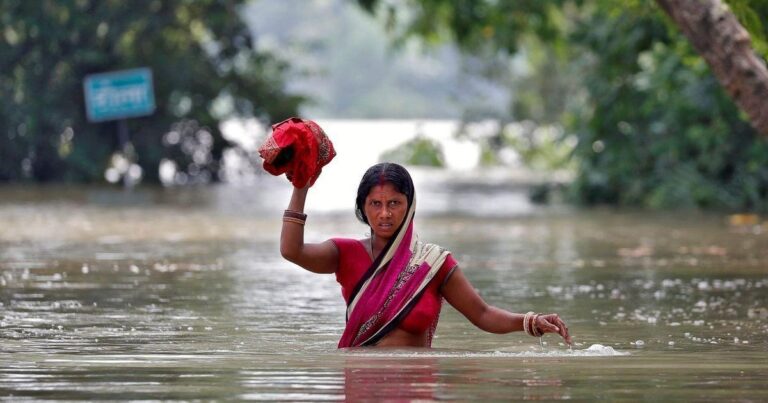The monsoon season has made an early arrival this year, with rains reaching Delhi and spreading across India a full nine days ahead of schedule, marking the fastest coverage since 2020. Meteorological departments across the country have noted this accelerated onset, offering a significant relief to parched regions and raising hopes for a bountiful agricultural season. This unexpected early downpour signals a shift in typical weather patterns, prompting experts and authorities to closely monitor its impact on urban and rural landscapes alike.
Monsoon Arrives Early Bringing Relief and Challenges Across India
The early arrival of the monsoon this year has brought much-needed respite to parched regions, especially the capital city of Delhi, which witnessed rains nearly a week and a half ahead of schedule. This accelerated progression marks the fastest monsoon coverage since 2020, with widespread showers now enveloping the majority of India’s geographical expanse. Farmers, water management authorities, and citizens welcomed the precipitation, hopeful that it will alleviate drought conditions in many drought-prone zones. However, the swift onset also poses logistical challenges, as urban areas grapple with the sudden heavy downpours leading to flooding, waterlogging, and disruptions in daily life.
- Regions Benefited: North India, Eastern states, Parts of Central India
- Challenges Faced: Urban flooding, damaged crops due to unseasonal rains, traffic disruptions
- Government Measures: Deployment of disaster response teams, alert systems in flood-prone districts
| State | Monsoon Arrival Date (2024) | Average Arrival Date | Difference (Days) |
|---|---|---|---|
| Delhi | June 5 | June 14 | -9 |
| Mumbai | June 3 | June 10 | -7 |
| Kolkata | June 6 | June 13 | -7 |
| Chennai | June 8 | June 15 | -7 |
While the advanced rains boost hopes for a stronger agricultural yield and replenished reservoirs, meteorologists caution that an intense monsoon season could follow, elevating risks of flooding and landslides in vulnerable regions. Officials urge preparedness and continuous monitoring to mitigate adverse impacts, balancing relief with caution as the country navigates the early but powerful arrival of monsoon showers.
Meteorological Factors Behind the Fastest Monsoon Spread Since 2020
The accelerated onset and rapid coverage of the monsoon this year can be largely attributed to an unusual alignment of key meteorological factors. A strong lower-level westerly wind flow facilitated swift moisture transport from the Arabian Sea towards the northern plains. Concurrently, an active El Niño-Southern Oscillation (ENSO) phase with subdued La Niña tendencies contributed to favorable temperature gradients, encouraging faster cloud formation and precipitation. The Arabian Sea, warmer than average by almost 1.2°C, provided an ample source of moisture, intensifying rainfall across central and northern India.
Additionally, the positioning of the monsoon trough has shifted southwards, enabling a broader expanse of the subcontinent to experience pre-monsoon showers. Below is an overview of the primary influencing factors accelerating this year’s monsoon spread:
- Enhanced Arabian Sea moisture transport
- Active low-pressure systems over the Bay of Bengal
- Stronger-than-usual westerlies over North India
- Warmer sea surface temperatures across the Indian Ocean
- Delayed retreat of Western Disturbances
| Meteorological Factor | Impact on Monsoon Spread |
|---|---|
| Arabian Sea SST Anomaly | +1.2°C – Increased moisture availability |
| Monsoon Trough Position | Southward shift – Broader rainfall distribution |
| Westerly Wind Speed | Strong – Faster moisture advection northwards |
| ENSO Phase | Neutral to weak El Niño – Supports rainfall stability |
Preparing for Early Rains How Residents and Authorities Can Stay Safe and Minimize Disruptions
As the monsoon sweeps across the region ahead of schedule, residents and city officials face the dual challenge of ensuring safety while maintaining normalcy. Local authorities are advised to intensify drainage maintenance and deploy emergency response teams to strategic locations prone to flooding. Citizens should prioritize securing their homes against water ingress and stay updated with official weather advisories. Preparing emergency kits with essentials and identifying nearby shelters can significantly reduce the risks posed by sudden heavy downpours.
Key precautions for residents include:
- Clearing clogged drains and gutters to prevent waterlogging
- Avoiding travel during peak rainfall periods
- Storing potable water and non-perishable food supplies
- Keeping electronic devices protected from moisture
Authorities meanwhile are advised to monitor early warning systems closely, coordinate with meteorological departments, and employ real-time communication channels to disseminate critical information. Mobilizing infrastructure repair crews in advance and ensuring power backup systems remain functional will help minimize disruptions during infrastructure stress caused by early monsoon showers.
| Preparedness Measure | Responsible Group | Timeline |
|---|---|---|
| Drain Clearing & Maintenance | Municipal Authorities | Immediate & Ongoing |
| Community Awareness Campaigns | Local NGOs & Media | Within 24 hours |
| Emergency Kit Distribution | Disaster Management Teams | Next 2 days |
| Real-time Weather Updates | Meteorological Department | Continuous |
In Conclusion
As the monsoon advances ahead of schedule, bringing much-needed respite to Delhi and large parts of India, meteorologists continue to monitor its swift progression closely. With rains enveloping the country nine days earlier than usual-the fastest onset since 2020-farmers, urban planners, and authorities are gearing up to manage both the benefits and challenges that come with early monsoon arrival. This development not only signals a dynamic start to the season but also underscores the importance of preparedness in the face of shifting climatic patterns.




